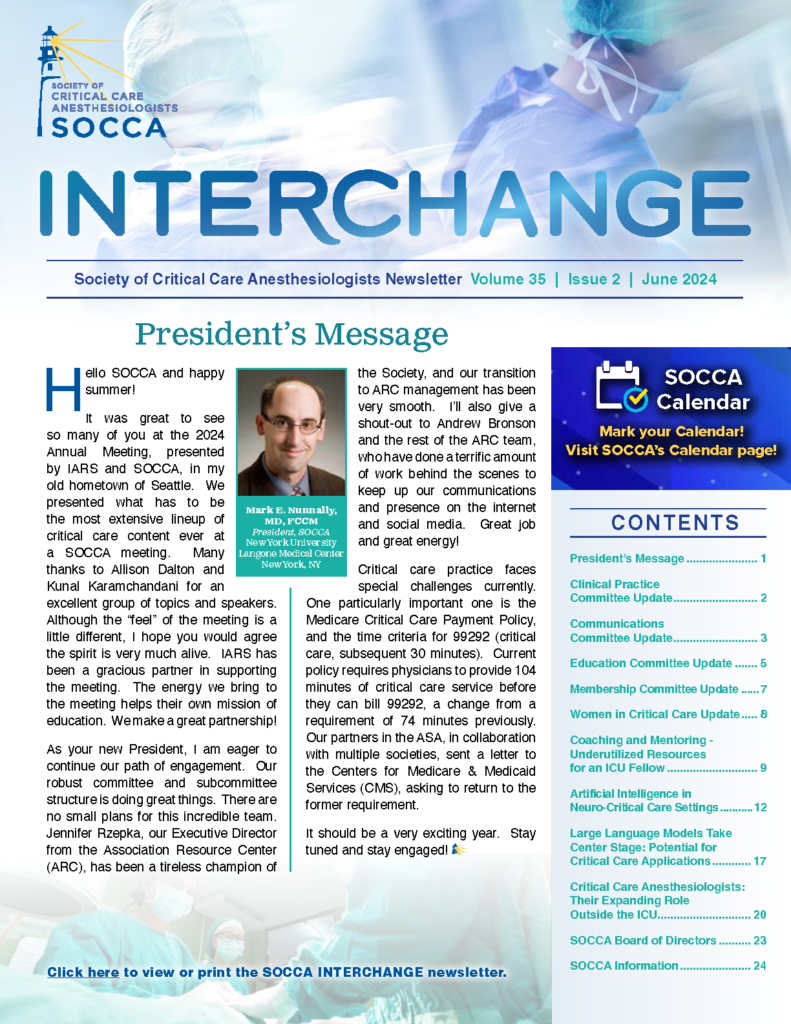Postoperative Pulmonary Complications: Is it Time for Intensivists to Take the Reins?
Postoperative pulmonary complications have been recognized and appreciated by physicians since symptoms of pneumonia were first described by Hippocrates, the father of western medicine, in 460 BC. Despite our extensive familiarity with this pervasive ailment, pneumonia remains the third-most common postoperative complication with an overall incidence of 1.3-1.8% 1. Data from The American College of Surgeon’s National Surgical Quality Improvement Program (NSQIP) calculated an estimated 1.8% incidence of postoperative pneumonia with a 17% mortality within 30 days across academic, community, and VA hospitals. Globally, 234 million surgeries are performed annually, and approximately 50 million occur in the United States. A conservative postoperative pneumonia incidence of 1% would therefore place the US at 500,000 cases of postoperative pneumonia. With hospital-acquired pneumonia carrying a median cost of $16,505-64,639 USD, this would suggest an economic burden in excess of $8.2-32.3 billion per annum 2!
Anesthesiologists and surgeons have recognized this problem and a number of studies have identified the perioperative factors of various surgical populations and intraoperative preventative strategies of varying success 3,4. Functional status, age, ASA class, COPD, preoperative sepsis, and smoking within one year before operation, and the type of operation were all risk factors identified by NSQIP in calculating the aggregate risk of postoperative pneumonia. Given that many of these preoperative risk factors are nonmodifiable at time of surgery, research has focused on determining effective perioperative strategies to mitigate postoperative pneumonia risk 5. Increasingly, attention has been devoted to preoperative rehabilitation to reduce postoperative pulmonary complications with positive results 6. As little as four weeks of strength and endurance training reduced postoperative respiratory morbidity in patients undergoing lung cancer resection 7. Caparelli and colleagues found an application of a simple oral care bundle resulted in a tremendous reduction in postoperative pneumonia 8.
A systematic review and meta-analysis by Odor and colleagues was able to identify several interventions that could reduce the incidence of postoperative pulmonary complications: use of enhanced recovery after surgery pathways, prophylactic mucolytics, postoperative continuous positive airway pressure non-invasive ventilation, lung protective intraoperative ventilation, prophylactic respiratory physiotherapy, epidural analgesia, and goal directed fluid and hemodynamic modalities. However, the accumulated evidence for these interventions is of only low to moderate quality, and the authors recommended better trial designs 9. Combined interventions, such as those in the I COUGH pulmonary care program, have proved to be more effective at reducing the incidence of postoperative pneumonia versus individual interventions 10. Six major components were grouped as part of the strategy executed via a standardized order set: incentive spirometry, coughing and deep breathing, oral care, understanding (patient and family engagement and education), getting out of bed frequently (at least 3 times daily), and consistent head-of-bed elevation. After implementation of this program, the authors found that the incidence of pneumonia fell from 2.6% to 1.6% and unplanned intubations decreased from 2% to 1.2%. Unlike a drug regimen, these types of bundled clinical interventions take substantial elbow grease from engaged participants to create an enduring institutional culture change. In turn, we believe studies like these represent an additional opportunity for perioperative physicians and surgical intensivists to take the lead in reducing postoperative pneumonia via:
- Institutional level education on early recognition of postoperative pneumonia.
- Providing leadership and research opportunities on intraoperative lung protection strategies.
- Championing the development of bundled care processes for the reduction of postoperative pneumonia.
- Development of multi-disciplinary preoperative rehabilitation opportunities for high-risk patients.
- Monitoring and correction of system-related delays in treatment of postoperative pneumonia.
As SOCCA’s 2021 Annual Meeting is rapidly approaching, we look forward to an exciting discussion about our specialty’s role in these matters, as Drs. Bender, Shaefi, Bartels, and Khanna examine potential interventions to assist in improving clinical outcomes in this important area. Be sure to be there!
References
- Chughtai M, Gwam CU, Khlopas A, et al. The incidence of postoperative pneumonia in various surgical subspecialties: a dual database analysis. Surg Technol Int. Jul 25 2017;30:45-51.
- Sun D, Moorthy V, Chang S-C, et al. Economic burden of ventilator-associated, hospital-acquired, healthcare-associated and community-acquired pneumonia in the hospital setting. Open Forum Infect Dis. 2016;3(suppl_1).
- Garibaldi RA, Britt MR, Coleman ML, et al. Risk factors for postoperative pneumonia. Am J Med. 1981;70(3):677-680.
- Russotto V, Sabaté S, Canet J for PERISCOPE group. Development of a prediction model for postoperative pneumonia: a multicentre prospective observational study. Eur J Anaesthesiol. Feb 2019;36(2):93-104.
- Gupta H, Gupta P, Schuller D, et al. Development and validation of a risk calculator for predicting postoperative pneumonia. Mayo Clin Proc. , 2013;88(11):1241-1249.
- Assouline B, Cools E, Schorer R, et al. Preoperative exercise training to prevent postoperative pulmonary complications in adults undergoing major surgery: a systematic review and meta-analysis with trial sequential analysis. Ann Am Thorac Soc. 2020;doi:10.1513/AnnalsATS.202002-183OC
- Morano MT, Araújo AS, Nascimento FB, et al. Preoperative pulmonary rehabilitation versus chest physical therapy in patients undergoing lung cancer resection: a pilot randomized controlled trial. Arch Phys Med Rehabil. Jan 2013;94(1):53-8.
- Caparelli ML, Shikhman A, Jalal A, et al. Prevention of postoperative pneumonia in noncardiac surgical patients: a prospective study using the National Surgical Quality Improvement Program database. Am Surg. 2019;85(1):8-14.
- Odor PM, Bampoe S, Gilhooly D, et al. Perioperative interventions for prevention of postoperative pulmonary complications: systematic review and meta-analysis. BMJ. 2020;368:m540.
- Cassidy MR, Rosenkranz P, McCabe K, et al. I COUGH: reducing postoperative pulmonary complications with a multidisciplinary patient care program. JAMA Surg. 2013;148(8):740-745.





































